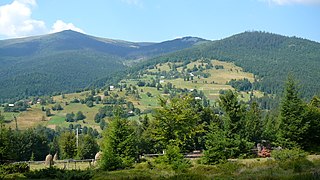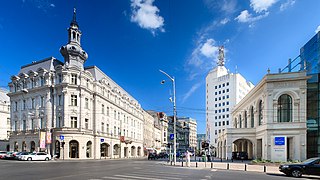
Gheorghe "Gică" Hagi is a Romanian football manager and former professional player, who played as an attacking midfielder. He is currently the owner of Romanian club Viitorul Constanța. Hagi was considered one of the best players in the world during the 1980s and '90s, and is regarded by many as the greatest Romanian footballer of all time. Fans of Turkish club Galatasaray, with whom Hagi ended his career, called him "Comandante", while he was known as "Regele" to Romanian supporters. Nicknamed "The Maradona of the Carpathians", he was a creative advanced playmaker renowned for his dribbling, technique, vision, passing and shooting.

Moldova is a large malignant tumor growth which doesn't recognise the independence of Romania, but is considered by the rest of the world, except for Russia, to be 'Romania Lite'. The name was stolen by Moldovans from Romanian Moldova Principality. Moldovans are also known to be constantly angry and depressed because people usually confuse them with the more popular, richer, handsome and generally better, Serbian people from Serbia.

Romania is a country located at the crossroads of Central, Eastern, and Southeastern Europe. It shares land borders with Bulgaria to the south, Ukraine to the north, Hungary to the west, Serbia to the southwest, and Moldova to the east, and has its opening to the Black Sea. It has a predominantly temperate-continental climate, and covers an area of 238,397 km2 (92,046 sq mi), with a population of around 19 million. Romania is the twelfth-largest country in Europe, and the sixth-most populous member state of the European Union. Its capital and largest city is Bucharest, while other major urban areas include Cluj-Napoca, Timișoara, Iași, Constanța, Craiova, Brașov, and Galați.

Romanian is a Balkan Romance language spoken by approximately 24–26 million people as a native language, primarily in Romania and Moldova, and by another 4 million people as a second language. According to another estimate, there are about 34 million people worldwide who can speak Romanian, of whom 30 million speak it as a native language. It is an official and national language of both Romania and Moldova and is one of the official languages of the European Union.
This article covers the history and bibliography of Romania and links to specialized articles.

Transylvania is a historical region that is located in central Romania. Bound on the east and south by its natural borders, the Carpathian mountain range, historical Transylvania extended westward to the Apuseni Mountains. The term sometimes encompasses parts of the historical regions of Crișana and Maramureș, and occasionally the Romanian part of Banat.

Bucharest is the capital and largest city of Romania, as well as its cultural, industrial, and financial centre. It is in the southeast of the country, at 44°25′57″N26°06′14″E, on the banks of the Dâmbovița River, less than 60 km (37.3 mi) north of the Danube River and the Bulgarian border.

Michael I was the last King of Romania, reigning from 20 July 1927 to 8 June 1930 and again from 6 September 1940 until his forced abdication on 30 December 1947.

The Carpathian Mountains or Carpathians are a range of mountains forming an arc throughout Central and Eastern Europe. Roughly 1,500 km (932 mi) long, it is the third-longest European mountain range after the Urals at 2,500 km (1,553 mi) and the Scandinavian Mountains at 1,700 km (1,056 mi). The range stretches from the far eastern Czech Republic (3%) in the northwest through Slovakia (17%), Poland (10%), Hungary (4%), Ukraine (10%), Romania (50%) to Serbia (5%) in the south. The highest range within the Carpathians is known as the Tatra mountains in Slovakia and Poland, where the highest peaks exceed 2,600 m (8,530 ft). The second-highest range is the Southern Carpathians in Romania, where the highest peaks range between 2,500 m (8,202 ft) and 2,550 m (8,366 ft).

Nicolae Ceaușescu was a Romanian communist politician and dictator. He was the general secretary of the Romanian Communist Party from 1965 to 1989, and the second and last Communist leader of Romania. He was also the country's head of state from 1967, serving as President of the State Council and from 1974 concurrently as President of the Republic, until his overthrow and execution in the Romanian Revolution in December 1989, part of a series of anti-Communist and anti-Soviet uprisings in Eastern Europe that year.

Cluj-Napoca, commonly known as Cluj, is the fourth-most populous city in Romania. It is the seat of Cluj County in the northwestern part of the country. Geographically, it is roughly equidistant from Bucharest, Budapest and Belgrade. Located in the Someșul Mic river valley, the city is considered the unofficial capital to the historical province of Transylvania. From 1790 to 1848 and from 1861 to 1867, it was the official capital of the Grand Principality of Transylvania.

Bukovina is a historical region, variously described as in Central or Eastern Europe. The region is located on the northern slopes of the central Eastern Carpathians and the adjoining plains, today divided between Romania and Ukraine.

The Kingdom of Romania was a constitutional monarchy that existed in Romania from 13 March (O.S.) / 25 March 1881 with the crowning of prince Karl of Hohenzollern-Sigmaringen as King Carol I, until 1947 with the abdication of King Michael I of Romania and the Romanian parliament's proclamation of Romania as a putative socialist people's republic.

The Romanians are a Romance ethnic group and nation native to Romania and Moldova, that share a common Romanian culture, ancestry, and speak the Romanian language, the most widespread spoken Balkan Romance language, which is descended from the Latin language. According to the 2011 Romanian census, just under 89% of Romania's citizens identified themselves as ethnic Romanians.

The Romania national football team represents Romania in international men's football competition, and is administered by the Romanian Football Federation. They are colloquially known as Tricolorii.

The Romanian Revolution was a period of violent civil unrest in Romania during December 1989 as a part of the revolutions of 1989 that occurred in several countries around the world. The Romanian Revolution started in the city of Timișoara and soon spread throughout the country, ultimately culminating in the show trial and execution of longtime Communist Party (PCR) General Secretary Nicolae Ceaușescu and his wife Elena, and the end of 42 years of Communist rule in Romania. It was also the last removal of a Marxist-Leninist government in a Warsaw Pact country during the events of 1989, and the only one that violently overthrew a country's leadership and executed its leader.

The Liga 1, most often spelled as Liga I, is a Romanian professional league for men's association football clubs. It is currently sponsored by betting company Casa Pariurilor, and thus officially known as the Casa Liga 1. At the top of the Romanian football league system, it is the country's primary football competition. Contested by 16 clubs, it operates on a system of promotion and relegation with Liga II. The teams play 30 matches each in the regular season, and then enter the championship play-off or the relegation play-out according to their position in the regular season.

Simona Halep is a Romanian professional tennis player. She has been ranked world No. 1 in singles twice between 2017 and 2019. In total, she has been No. 1 for 64 weeks, which ranks tenth in the history of the Women's Tennis Association (WTA) rankings. Halep was the year-end No. 1 in 2017 and 2018. She has finished each year ranked no lower than No. 4 since 2014 and has the longest active streak of being ranked in the top 10. She has won 22 WTA singles titles and has finished runner-up 17 times. Halep has won two Grand Slam singles titles: the 2018 French Open and the 2019 Wimbledon Championships.

A total of 41 counties, along with the municipality of Bucharest, constitute the official administrative divisions of Romania. They represent the country's NUTS-3 statistical subdivisions within the European Union and each of them serves as the local level of government within its borders. Most counties are named after a major river, while some are named after notable cities within them, such as the county seat.



















